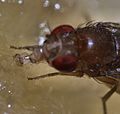Drosophilidae facts for kids
The Drosophilidae are a diverse, cosmopolitan family of flies, which includes fruit flies. The family has over 4000 species in 75 genera.
The best known species of the Drosophilidae is Drosophila melanogaster. This species is used extensively for studies on genetics, development, physiology, and behaviour.
D. melanogaster is not so much studied in the field as in the laboratory. The best-known studies of Drosophila in a natural environment was done by Dobzhansky and colleagues on Drosophila pseudoobscura from the early 1930s to 1970. Reprints and discussions are in Lewontin et al 2003, and theoretical discussions in Dobzhansky, 1970.
The cells of fruit flies usually do not divide after the imago is hatched. The fruit fly is mostly composed of post-mitotic cells, has a very short lifespan, and shows gradual ageing. As in other species, temperature influences the life history of the animal. They live longer in colder weather. Several genes can be manipulated to extend the lifespan of these insects.
There is another, unrelated, family of flies, the Tephritidae. It also includes species known as "small fruit flies".
The Drosophilidae has two subfamilies, the Drosophilinae and the Steganinae.
Images for kids
-
Drosophilidae compound eye
See also
 In Spanish: Drosofílidos para niños
In Spanish: Drosofílidos para niños




